Assessment of Special Rubberized Concrete Types Utilizing Portable Non-Destructive Tests
Abstract
:1. Introduction
2. Materials and Methods
2.1. Cement
2.2. Fine and Coarse Aggregates
2.3. Crumb Rubber
2.4. Superplasticizer
3. Specimens Preparation
4. Testing Method
5. Results and Discussion
5.1. Slump
5.2. Density
5.3. Mechanical Properties
5.3.1. Compressive Strength
5.3.2. Flexural Strength
5.3.3. Splitting Tensile Strength
5.3.4. Relationship between Strengths
5.3.5. Impact Resistance
5.4. Non-Destructive Testing
5.4.1. Rebound Number
5.4.2. UPV
5.4.3. Dynamic Modulus of Elasticity (DMOE)
6. Conclusions
- The optimum percentile of crumb rubber was deduced for each concrete type: NC, SCC, and RCC. The difference in the percentile replacement and whether to replace fine, coarse, or total aggregate is attributed to the difference in the design and their basis. For instance, SCC relies mainly on rheological properties when designing its concrete mixes, while RCC uses the optimum water content.
- The crumb rubber reduces the strength properties of the concrete, regardless of the type of concrete used: NC, RCCor, or even SCC.
- The optimum percentile of replacement is for NC 25% of coarse aggregate, for SCC 10% of fine aggregate, and for RCC 10% of the total aggregate.
- Densities are not affected significantly by the replacement with crumb rubber as the volume would be occupied if even the specific gravity is different.
- Slumps will not be influenced or can be negligible in significance as the shape of crumb rubber would shape workability more than its characteristics.
- Compressive, flexural, and tensile strengths reduced at the optimum percentile of replacement due to the weakening of ITZ between the cement matrix and the aggregate; crumb rubber and aggregate, in addition to the existence of the air content that generated from the entrapped air while mixing when utilizing crumb rubber, increasing the porosity and therefore reduces the strength.
- For flexural and tensile strengths, the reduction is not significant as the crumb rubber acts as a fiber-bridging arch, preventing the crack width from increasing and propagating more.
- The impact of rubberized concrete tends towards reducing the brittleness of concrete and increasing its ductility.
- Treatment of crumb rubber is essential in most cases to roughen the surface and increase the bond at ITZ between the cement matrix, crumb rubber, and aggregate.
- The correlation between the rebound number and compressive strength is linear and can be deduced for rubberized concrete, but the opposite is not possible for UPV and DMOE concrete.
- Homogeneity of the rubberized concrete is ensured through the UPV, although the deduced porosity that appears in the reduction of the UPV is relevant to the control mixes.
Author Contributions
Funding
Institutional Review Board Statement
Informed Consent Statement
Data Availability Statement
Acknowledgments
Conflicts of Interest
References
- Anf, H.Z.; Emad, S. An environmental impact assessment of the open burning of scrap tires. J. Appl. Sci. 2014, 14, 2695–2703. [Google Scholar]
- U.S. Environmental Protection Agency. Methyl Bromide Consumption Estimates; U.S. Environmental Protection Agency: Washington, DC, USA, 1995.
- Lewtas, J. Air pollution combustion emissions: Characterization of causative agents and mechanisms associated with cancer, reproductive, and cardiovascular effects. Mutat. Res./Rev. Mutat. Res. 2007, 636, 95–133. [Google Scholar] [CrossRef] [PubMed]
- EcoGreen LLC. Environmental Impacts of Waste Tire Disposal; EcoGreen LLC: North Salt Lake, UT, USA, 2021; Available online: https://ecogreenequipment.com/environmental-impacts-of-waste-tire-disposal/ (accessed on 5 January 2021).
- Karaağaç, B.; Ercan Kalkan, M.; Deniz, V. End-of-life tire management: Turkey case. J. Mater. Cycles Waste Manag. 2015, 19, 577–584. [Google Scholar] [CrossRef]
- Bond, T.C.; Streets, D.G.; Yarber, K.F.; Nelson, S.M.; Woo, J.; Klimont, Z. A technology-based global inventory of black and organic carbon emissions from combustion. J. Geophys. Res. Atmos. 2004, 109, D14. [Google Scholar] [CrossRef]
- Downard, J.; Singh, A.; Bullard, R.; Jayarathne, T.; Rathnayake, C.M.; Simmons, D.L.; Wels, B.R.; Spak, S.N.; Peters, T.; Beardsley, D.; et al. Uncontrolled combustion of shredded tires in a landfill—Part 1: Characterization of gaseous and particulate emissions. Atmos. Environ. 2015, 104, 195–204. [Google Scholar] [CrossRef]
- Lemieux, P.; Stewart, E.; Realff, M.; Mulholland, J.A. Emissions study of co-firing waste carpet in a rotary kiln. J. Environ. Manag. 2004, 70, 27–33. [Google Scholar] [CrossRef] [PubMed]
- Pendry, L.; Lashkari, G.; Bewley, H. 2003 Children’s Dental Health Survey; Office for National Statistics: London, UK, 2004.
- Ofuyatan, O.M.; Adeniyi, A.G.; Ijie, D.; Ighalo, J.O.; Oluwafemi, J. Development of high-performance self-compacting concrete using eggshell powder and blast furnace slag as partial cement replacement. Constr. Build. Mater. 2020, 256, 119403. [Google Scholar] [CrossRef]
- Shawki, M.A.; Elnemr, A.; Koenke, C.; Thomas, C. Rheological properties of high-performance SCC using recycled marble powder. Innov. Infrastruct. Solut. 2024, 9, 176. [Google Scholar] [CrossRef]
- Pang, L.; Liu, Z.; Wang, D.; An, M. Review on the Application of Supplementary Cementitious Materials in Self-Compacting Concrete. Crystals 2022, 12, 180. [Google Scholar] [CrossRef]
- Bignozzi, M.C.; Sandrolini, F. Tyre rubber waste recycling in self-compacting concrete. Cem. Concr. Res. 2006, 36, 735–739. [Google Scholar] [CrossRef]
- Yung, W.H.; Yung, L.C.; Hua, L.H. A study of the durability properties of waste tire rubber applied to self-compacting concrete. Constr. Build. Mater. 2013, 41, 665–672. [Google Scholar] [CrossRef]
- Sun, C.; Chen, Q.; Xiao, J.; Liu, W. Utilization of waste concrete recycling materials in self-compacting concrete. Resour. Conserv. Recycl. 2020, 161, 104930. [Google Scholar] [CrossRef]
- Ullah Khan, S.; Ahmed, A.; Ali, S.; Ayub, A.; Shuja, A.; Ahsan Shahid, M. Use of Scrapped Rubber Tyres for Sustainable Construction of Manhole Covers. J. Renew. Mater. 2021, 9, 1013–1029. [Google Scholar] [CrossRef]
- Etli, S. Evaluation of the effect of silica fume on the fresh, mechanical, and durability properties of self-compacting concrete produced by using waste rubber as fine aggregate. J. Clean. Prod. 2023, 384, 135590. [Google Scholar] [CrossRef]
- Siddique, R. Utilization (recycling) of iron and steel industry by-product (GGBS) in concrete: Strength and durability properties. J. Mater. Cycles Waste Manag. 2013, 16, 460–467. [Google Scholar] [CrossRef]
- Rodsin, K.; Joyklad, P.; Hussain, Q.; Mohamad, H.; Buatik, A.; Zhou, M.; Chaiyasarn, K.; Nawaz, A.; Mehmood, T.; Elnemr, A. Behavior of steel clamp confined brick aggregate concrete circular columns subjected to axial compression. Case Stud. Constr. Mater. 2022, 16, e00815. [Google Scholar] [CrossRef]
- Ayub, T.; Khan, S.U.; Mahmood, W. Mechanical Properties of Self-Compacting Rubberised Concrete (SCRC) Containing Polyethylene Terephthalate (PET) Fibres. Iran. J. Sci. Technol. Trans. Civ. Eng. 2021, 46, 1073–1085. [Google Scholar] [CrossRef]
- Romeo, E.; Freddi, F.; Montepara, A. Mechanical behavior of surface layer fiberglass-reinforced flexible pavements. Int. J. Pavement Eng. 2013, 15, 95–109. [Google Scholar] [CrossRef]
- Zhu, X.; Qian, G.; Yu, H.; Yao, D.; Shi, C.; Zhang, C. Evaluation of coarse aggregate movement and contact unbalanced force during asphalt mixture compaction process based on discrete element method. Constr. Build. Mater. 2022, 328, 127004. [Google Scholar] [CrossRef]
- Ashrafian, A.; Gandomi, A.H.; Rezaie-Balf, M.; Emadi, M. An evolutionary approach to formulate the compressive strength of roller compacted concrete pavement. Measurement 2020, 152, 107309. [Google Scholar] [CrossRef]
- Liu, H.; Wang, X.; Jiao, Y.; Sha, T. Experimental Investigation of the Mechanical and Durability Properties of Crumb Rubber Concrete. Materials 2016, 9, 172. [Google Scholar] [CrossRef] [PubMed]
- Choi, Y.; Kim, I.-H.; Lim, H.-J.; Cho, C.-G. Investigation of Strength Properties for Concrete Containing Fine-Rubber Particles Using UPV. Materials 2022, 15, 3452. [Google Scholar] [CrossRef] [PubMed]
- Alwesabi, E.A.; Abu Bakar, B.H.; Alshaikh, I.M.H.; Akil, H.M. Impact resistance of plain and rubberized concrete containing steel and polypropylene hybrid fiber. Mater. Today Commun. 2020, 25, 101640. [Google Scholar] [CrossRef]
- Ebewele, R.O.; Dzong, L.H. Potential application of recycled rubber. Niger. J. Eng. 1990, 6, 1–3. [Google Scholar]
- Ozbay, E.; Lachemi, M.; Sevim, U.K. Compressive strength, abrasion resistance, and energy absorption capacity of rubberized concrete with and without slag. Mater. Struct. 2010, 44, 1297–1307. [Google Scholar] [CrossRef]
- Shaaban, I.G.; Rizzuto, J.P.; El-Nemr, A.; Bohan, L.; Ahmed, H.; Tindyebwa, H. Mechanical Properties and Air Permeability of Concrete Containing Waste Tires Extracts. J. Mater. Civ. Eng. 2021, 33, 04020472. [Google Scholar] [CrossRef]
- Al-Osta, M.A.; Ahmad, S.; Al-Madani, M.K.; Khalid, H.R.; Al-Huri, M.; Al-Fakih, A. Performance of bond strength between ultra-high-performance concrete and concrete substrates (concrete screed and self-compacted concrete): An experimental study. J. Build. Eng. 2022, 51, 104291. [Google Scholar] [CrossRef]
- Shaaban, I.; Rizzuto, J.; El Nemr, A.; Elsayad, H.; Mowad, A. Silica fume and crumb rubber as partial replacement of cement and fine aggregate concrete. In Proceedings of the 2nd International Summit on Civil, Structural, and Environmental Engineering, Florence, Italy, 18–20 March 2024. [Google Scholar]
- Oluwafemi, J.; Ofuyatan, O.; Adedeji, A.; Bankole, D.; Justin, L. Reliability assessment of ground granulated blast furnace slag/cow bone ash-based geopolymer concrete. J. Build. Eng. 2023, 64, 105620. [Google Scholar] [CrossRef]
- Ofuyatan, O.M.; Olutoge, F.; Omole, D.; Babafemi, A. Influence of palm ash on properties of lightweight self-compacting concrete. Clean. Eng. Technol. 2021, 4, 100233. [Google Scholar] [CrossRef]
- Mhaya, A.M.; Huseien, G.F.; Abidin AR, Z.; Ismail, M. Long-term mechanical and durable properties of waste tire rubber crumbs replaced GBFS-modified concretes. Constr. Build. Mater. 2020, 256, 119505. [Google Scholar] [CrossRef]
- Uche, O.A.; Kelechi, S.E.; Adamu, M.; Ibrahim, Y.E.; Alanazi, H.; Okokpujie, I.P. Modeling and Optimizing the Durability Performance of Self-Consolidating Concrete Incorporating Crumb Rubber and Calcium Carbide Residue Using Response Surface Methodology. Buildings 2022, 12, 398. [Google Scholar] [CrossRef]
- Liu, Z.; Chen, X.; Wang, X.; Diao, H. Investigation on the dynamic compressive behavior of waste tires rubber-modified self-compacting concrete under multiple impacts loading. J. Clean. Prod. 2022, 336, 130289. [Google Scholar] [CrossRef]
- Chen, J.; Zhuang, J.; Shen, S.; Dong, S. Experimental investigation on the impact resistance of rubber self-compacting concrete. Structures 2022, 39, 691–704. [Google Scholar] [CrossRef]
- Li, X.; Ma, F.; Chen, X.; Hu, J.; Wang, J. Fracture behavior investigation of self-compacting rubberized concrete by DIC and mesoscale modeling. J. Clean. Prod. 2023, 384, 135503. [Google Scholar] [CrossRef]
- Islam, M.T.; Hasan, K.; Khalid, Z.B.; Yahaya, F.M. A comprehensive review of the features of self-compacting rubberized concrete in the fresh and hardened states. Archit. Struct. Constr. 2022, 3, 41–63. [Google Scholar] [CrossRef]
- Ismail, M.K.; Hassan, A.A.A. Use of metakaolin to enhance the mechanical properties of self-consolidating concrete containing high percentages of crumb rubber. J. Clean. Prod. 2016, 125, 282–295. [Google Scholar] [CrossRef]
- AbdelAleem, B.H.; Hassan AA, A. Development of self-consolidating rubberized concrete incorporating silica fume. Constr. Build. Mater. 2018, 161, 389–397. [Google Scholar] [CrossRef]
- Ganesan, N.; Bharati Raj, J.; Shashikala, A.P. Flexural fatigue behavior of self-compacting rubberized concrete. Constr. Build. Mater. 2013, 44, 7–14. [Google Scholar] [CrossRef]
- Bideci, A.; Öztürk, H.; Bideci, Ö.S.; Emiroğlu, M. Fracture energy and mechanical characteristics of self-compacting concrete including waste bladder tire. Constr. Build. Mater. 2017, 149, 669–678. [Google Scholar] [CrossRef]
- AbdelAleem, B.H.; Ismail, M.K.; Hassan, A.A.A. The combined effect of crumb rubber and synthetic fibers on the impact resistance of self-consolidating concrete. Constr. Build. Mater. 2018, 162, 816–829. [Google Scholar] [CrossRef]
- Ismail, M.K.; Hassan, A.A.A. Impact Resistance and Mechanical Properties of Self-Consolidating Rubberized Concrete Reinforced with Steel Fibers. J. Mater. Civ. Eng. 2017, 29, 04016193. [Google Scholar] [CrossRef]
- Mishra, M.; Panda, K.C. An Experimental Study on Fresh and Hardened Properties of Self-Compacting Rubberized Concrete. Indian J. Sci. Technol. 2015, 8, 29. [Google Scholar] [CrossRef]
- Aslani, F.; Ma, G.; Yim Wan, D.L.; Muselin, G. Development of high-performance self-compacting concrete using waste recycled concrete aggregates and rubber granules. J. Clean. Prod. 2018, 182, 553–566. [Google Scholar] [CrossRef]
- Uygunoğlu, T.; Topçu, İ.B. The role of scrap rubber particles on the drying shrinkage and mechanical properties of self-consolidating mortars. Constr. Build. Mater. 2010, 24, 1141–1150. [Google Scholar] [CrossRef]
- Aslani, F.; Ma, G.; Yim Wan, D.L.; Tran Le, V.X. Experimental investigation into rubber granules and their effects on the fresh and hardened properties of self-compacting concrete. J. Clean. Prod. 2018, 172, 1835–1847. [Google Scholar] [CrossRef]
- Rahmani, Y.; Sohrabi, M.R.; Askari, A. Mechanical Properties of Rubberized Self-Compacting Concrete Containing Silica Fume. Adv. Mater. Res. 2011, 261–263, 441–445. [Google Scholar] [CrossRef]
- Etli, S.; Cemalgil, S. Effects of Specimen Size on The Compressive Strength of Rubber Modified Self-Compacting Concrete. Int. J. Pure Appl. Sci. 2020, 6, 118–129. [Google Scholar] [CrossRef]
- Chen, C.; Chen, X.; Zhang, J. Experimental study on flexural fatigue behavior of self-compacting concrete with waste tire rubber. Mech. Adv. Mater. Struct. 2019, 28, 1691–1702. [Google Scholar] [CrossRef]
- Raj, B.; Ganesan, N.; Shashikala, A.P. Engineering properties of self-compacting rubberized concrete. J. Reinf. Plast. Compos. 2011, 30, 1923–1930. [Google Scholar] [CrossRef]
- Mallek, J.; Daoud, A.; Omikrine-Metalssi, O.; Loulizi, A. Performance of self-compacting rubberized concrete against carbonation and chloride penetration. Struct. Concr. 2021, 22, 2720–2735. [Google Scholar] [CrossRef]
- Anil Thakare, A.; Siddique, S.; Sarode, S.N.; Deewan, R.; Gupta, V.; Gupta, S.; Chaudhary, S. A study on rheological properties of rubber fiber dosed self-compacting mortar. Constr. Build. Mater. 2020, 262, 120745. [Google Scholar] [CrossRef]
- Bušić, R.; Benšić, M.; Miličević, I.; Strukar, K. Prediction Models for the Mechanical Properties of Self-Compacting Concrete with Recycled Rubber and Silica Fume. Materials 2020, 13, 1821. [Google Scholar] [CrossRef] [PubMed]
- Yang, G.; Chen, X.; Guo, S.; Xuan, W. Dynamic Mechanical Performance of Self-compacting Concrete Containing Crumb Rubber under High Strain Rates. KSCE J. Civ. Eng. 2019, 23, 3669–3681. [Google Scholar] [CrossRef]
- Si, R.; Wang, J.; Guo, S.; Dai, Q.; Han, S. Evaluation of laboratory performance of self-consolidating concrete with recycled tire rubber. J. Clean. Prod. 2018, 180, 823–831. [Google Scholar] [CrossRef]
- Khalil, E.; Abd-Elmohsen, M.; Anwar, A.M. Impact Resistance of Rubberized Self-Compacting Concrete. Water Sci. 2015, 29, 45–53. [Google Scholar] [CrossRef]
- Zaoiai, S.; Makani, A.; Tafraoui, A.; Benmerioul, F. Optimization and mechanical characterization of self-compacting concrete incorporating rubber aggregates. Asian J. Civ. Eng. 2016, 17, 817–829. [Google Scholar]
- Güneyisi, E.; Gesoglu, M.; Naji, N.; İpek, S. Evaluation of the rheological behavior of fresh self-compacting rubberized concrete by using the Herschel–Bulkley and modified Bingham models. Arch. Civ. Mech. Eng. 2016, 16, 9–19. [Google Scholar] [CrossRef]
- Miličević, I.; Hadzima-Nyarko, M.; Bušić, R.; Simonović Radosavljević, J.; Prokopijević, M.; Vojisavljević, K. Effect of rubber treatment on compressive strength and modulus of elasticity of self-compacting rubberized concrete. In ICACM 2021-15, Proceedings of the International Conference on Advanced Construction Materials, Part VIII, Paris, France, 19–20 April 2021; World Academy of Science, Engineering and Technology: New York, NY, USA, 2021; pp. 651–654. [Google Scholar]
- Hesami, S.; Salehi Hikouei, I.; Emadi, S.A.A. Mechanical behavior of self-compacting concrete pavements incorporating recycled tire rubber crumb and reinforced with polypropylene fiber. J. Clean. Prod. 2016, 133, 228–234. [Google Scholar] [CrossRef]
- Alaloul, W.S.; Musarat, M.A.; Haruna, S.; Law, K.; Tayeh, B.A.; Rafiq, W.; Ayub, S. Mechanical Properties of Silica Fume Modified High-Volume Fly Ash Rubberized Self-Compacting Concrete. Sustainability 2021, 13, 5571. [Google Scholar] [CrossRef]
- Keleş, Ö.F.; Bayrak, O.Ü.; Bayata, H.F. Experimental investigation on mechanical properties of sustainable roller compacted concrete pavement (RCCP) containing waste rubbers as alternative aggregates. Constr. Build. Mater. 2024, 424, 135930. [Google Scholar] [CrossRef]
- Mohammed, B.S.; Adamu, M.; Liew, M.S. Evaluating the effect of crumb rubber and nano-silica on the properties of high volume fly ash roller compacted concrete pavement using non-destructive techniques. Case Stud. Constr. Mater. 2018, 8, 380–391. [Google Scholar] [CrossRef]
- Mohammed, B.S.; Adamu, M. Mechanical performance of roller compacted concrete pavement containing crumb rubber and nano-silica. Constr. Build. Mater. 2018, 159, 234–251. [Google Scholar] [CrossRef]
- Adamu, M.; Mohammed, B.S.; Shahir Liew, M. Mechanical properties and performance of high volume fly ash roller compacted concrete containing crumb rubber and nano-silica. Constr. Build. Mater. 2018, 171, 521–538. [Google Scholar] [CrossRef]
- Meddah, A.; Beddar, M.; Bali, A. Use of shredded rubber tire aggregates for roller-compacted concrete pavement. J. Clean. Prod. 2014, 72, 187–192. [Google Scholar] [CrossRef]
- Fakhri, M.; Saberi, K.F. The effect of waste rubber particles and silica fume on the mechanical properties of Roller Compacted Concrete Pavement. J. Clean. Prod. 2016, 129, 521–530. [Google Scholar] [CrossRef]
- Corinaldesi, V.; Mazzoli, A.; Moriconi, G. Mechanical behavior and thermal conductivity of mortars containing waste rubber particles. Mater. Des. 2011, 32, 1646–1650. [Google Scholar] [CrossRef]
- Adamu, M.; Mohammed, B.S.; Shafiq, N. Mechanical performance of Roller roller-compacted rubbercrete with different mineral fillers. J. Teknol. 2017, 79, 75–88. [Google Scholar] [CrossRef]
- Jingfu, K.; Chuncui, H.; Zhenli, Z. Strength and shrinkage behaviors of roller-compacted concrete with rubber additives. Mater. Struct. 2008, 42, 1117–1124. [Google Scholar] [CrossRef]
- Adamu, M.; Haruna, S.I.; Ibrahim, Y.E.; Alanazi, H. Investigating the properties of roller-compacted rubberized concrete modified with nano-silica using response surface methodology. Innov. Infrastruct. Solut. 2021, 7, 119. [Google Scholar] [CrossRef]
- ASTM C33; Specification for Concrete Aggregates. ASTM International: West Conshohocken, PA, USA, 2011. [CrossRef]
- ECP 203; Egyptian Code of Practice for Reinforced Concrete Design and Construction ECP-203-2020. ECP: Giza, Egypt, 2020.
- BS 882 (1992); Specification for Aggregates from Natural Resources for Concrete. BSI British Standards: London, UK, 1992. [CrossRef]
- ASTM C494/C494M; Specification for Chemical Admixtures for Concrete. ASTM International: West Conshohocken, PA, USA, 2019. [CrossRef]
- ASTM C1017/C1017M; Standard Specification for Chemical Admixtures for Use in Producing Flowing Concrete. ASTM International: West Conshohocken, PA, USA, 2013.
- ACI Committee 327. Guide to Roller-Compacted Concrete Pavements; American Concrete Institute: Indianapolis, IN, USA, 2015. [Google Scholar]
- Dale, H.; Fares, A.; Wayne, A.; Chetan, H. Guide for Roller Compacted Concrete Pavements; Iowa State University, National Concrete Pavement Technology Center, Portland Cement Association (PCA): Skokie, IL, USA, 2010; pp. 1–114. [Google Scholar]
- Elnemr, A.; Shaltout, R. Rheological and Mechanical Characterization of Self-Compacting Concrete using Recycled Aggregate. Preprints 2024, 2024041815. [Google Scholar] [CrossRef]
- ASTM C143; Test Method for Slump of Hydraulic-Cement Concrete. ASTM International: West Conshohocken, PA, USA, 2012. [CrossRef]
- ASTM C1611; Test Method for Slump Flow of Self-Consolidating Concrete. ASTM International: West Conshohocken, PA, USA, 2021. [CrossRef]
- ASTM C1621; Test Method for Passing Ability of Self-Consolidating Concrete by J-Ring. ASTM International: West Conshohocken, PA, USA, 2017. [CrossRef]
- EN 12350-9; Testing Fresh Concrete—Part 9: Self-Compacting Concrete—V-Funnel Test. BSI: London, UK, 2010.
- EN 12350-10; Testing Fresh Concrete—Part 10: Self-Compacting Concrete—L-Box Test. BSI: London, UK, 2010.
- BS 812-112: 1990; Testing Aggregates—Part 112: Methods for Determination of Aggregate Impact Value (AIV). British Standards Institution: London, UK, 1975.
- ACI Committee 544. ACI 544.2R (1989): Measurement of Properties of Fiber Reinforced Concrete. In ACI Manual of Concrete Practice, Part 5, Masonry, Precast Concrete and Special Processes; American Concrete Institute: Indianapolis, IN, USA, 1996. [Google Scholar]
- Eren, Ö.; Marar, K.; Çelik, T. Effects of Silica Fume and Steel Fibers on Some Mechanical Properties of High-Strength Fiber-Reinforced Concrete. J. Test. Eval. 1999, 27, 380–387. [Google Scholar] [CrossRef]
- ASTM C597; Test Method for Pulse Velocity through Concrete. ASTM International: West Conshohocken, PA, USA, 2022. [CrossRef]
- Reda Taha, M.M.; El-Dieb, A.S.; Abd El-Wahab, M.A.; Abdel-Hameed, M.E. Mechanical, Fracture, and Microstructural Investigations of Rubber Concrete. J. Mater. Civ. Eng. 2008, 20, 640–649. [Google Scholar] [CrossRef]
- BIBM; CEMBUREAU; ERMCO; EFCA; EFNARC. The European Guidelines for Self-Compacting Concrete. Specification, Production and Use; EFNARC, Association House: Farnham, UK, 2005; p. 63. [Google Scholar]
- Naito, C.; States, J.; Jackson, C.; Bewick, B. Assessment of Crumb Rubber Concrete for Flexural Structural Members. J. Mater. Civ. Eng. 2014, 26, 04014075. [Google Scholar] [CrossRef]
- ASTM C231; Test Method for Air Content of Freshly Mixed Concrete by the Pressure Method. ASTM International: West Conshohocken, PA, USA, 2009. [CrossRef]
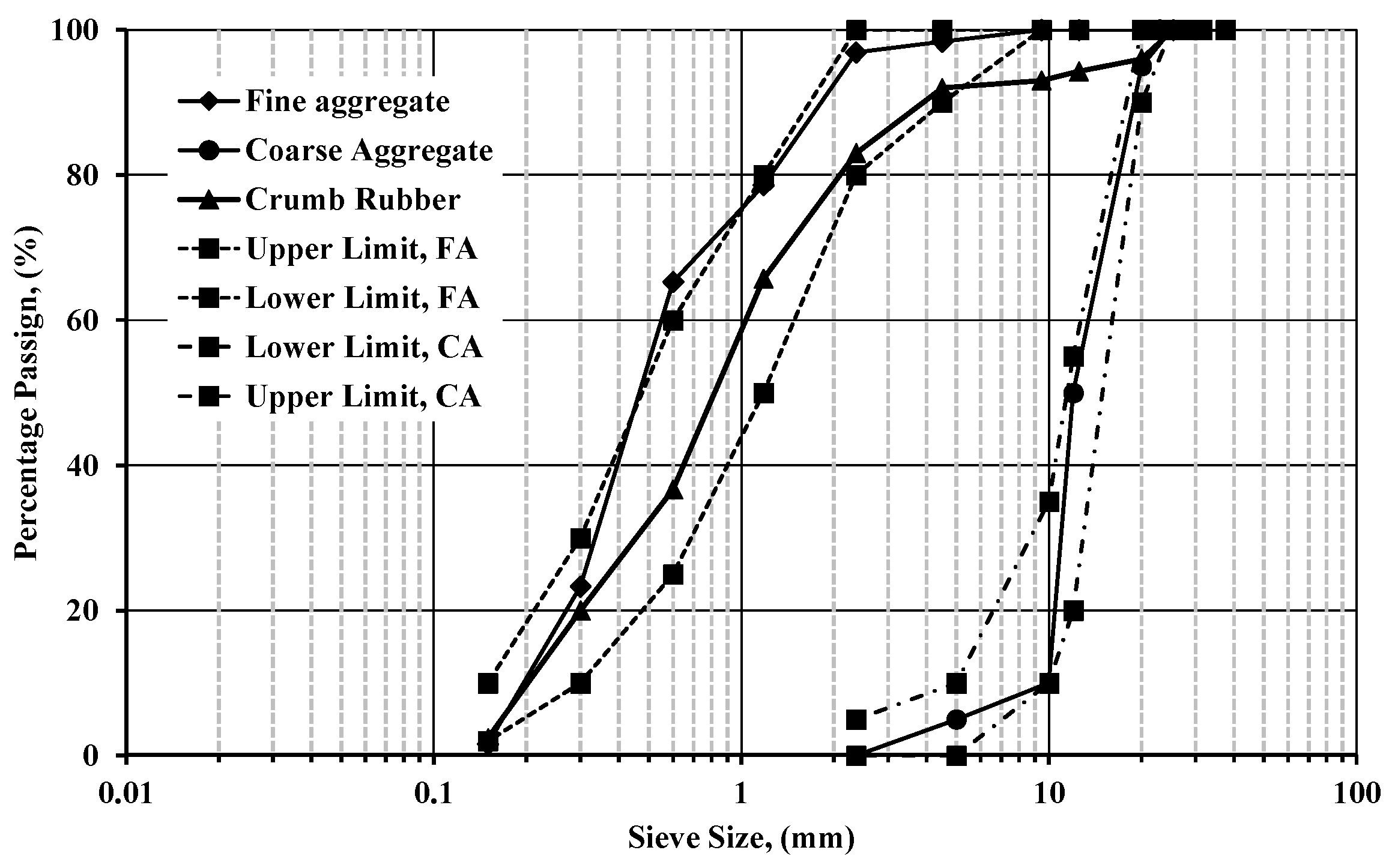


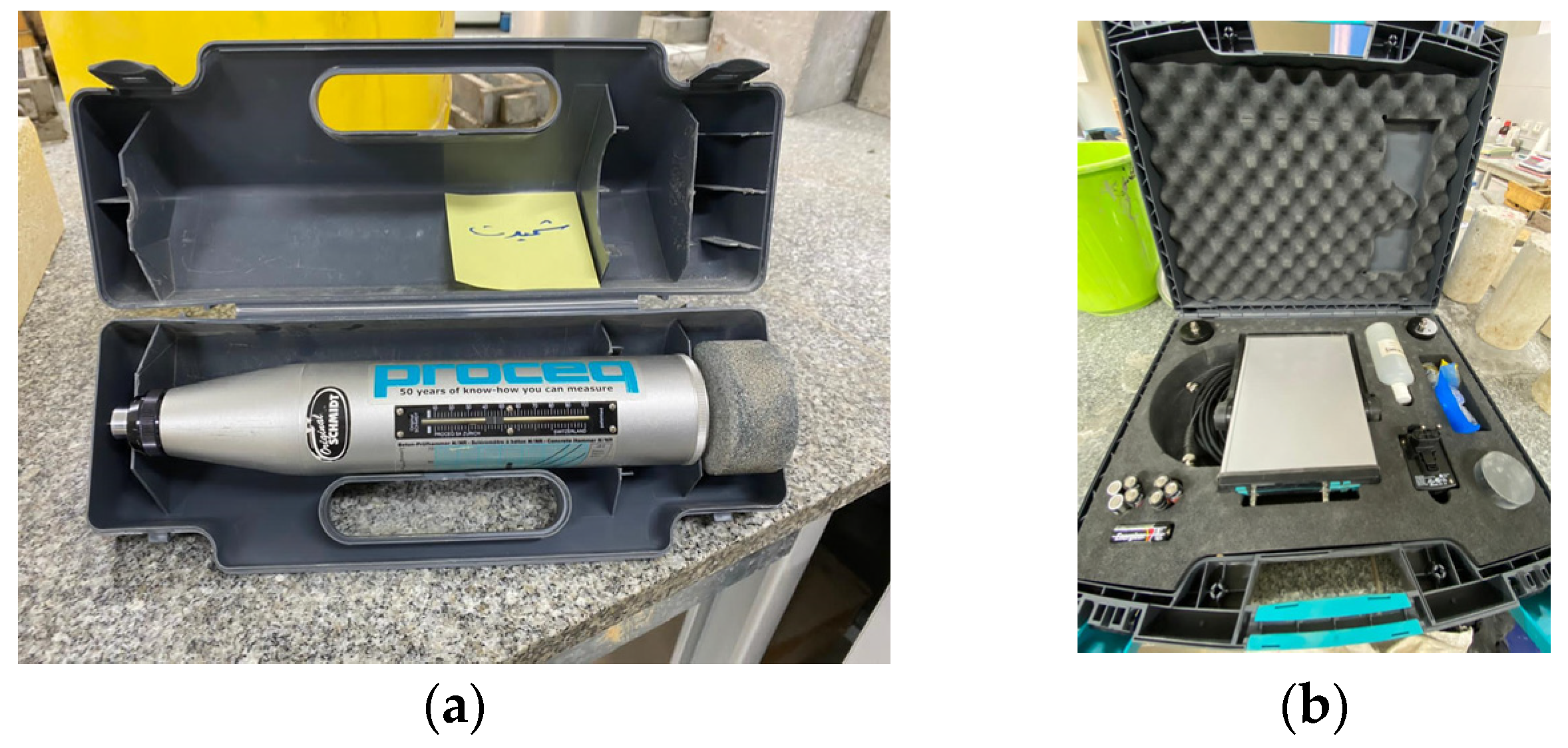
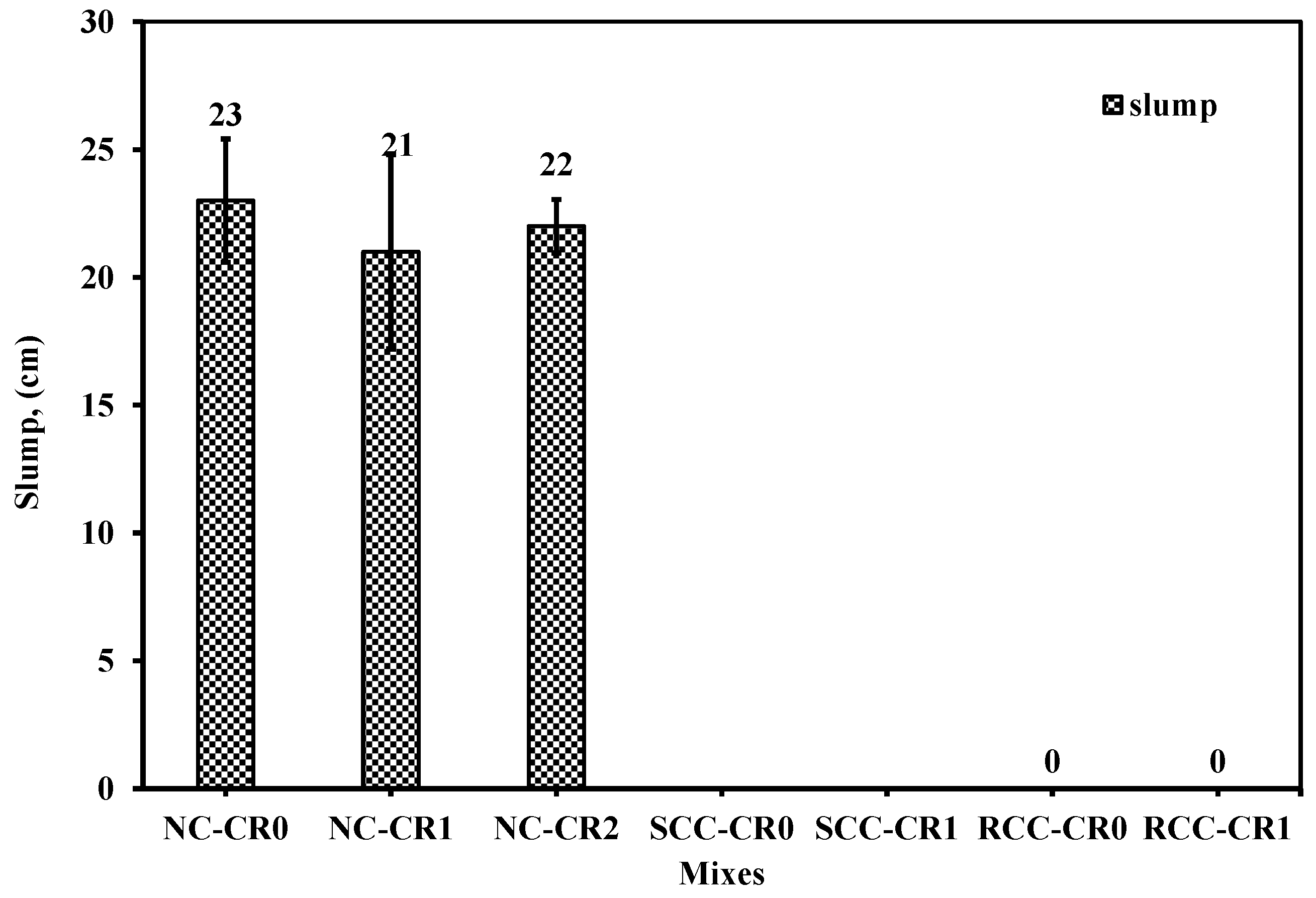




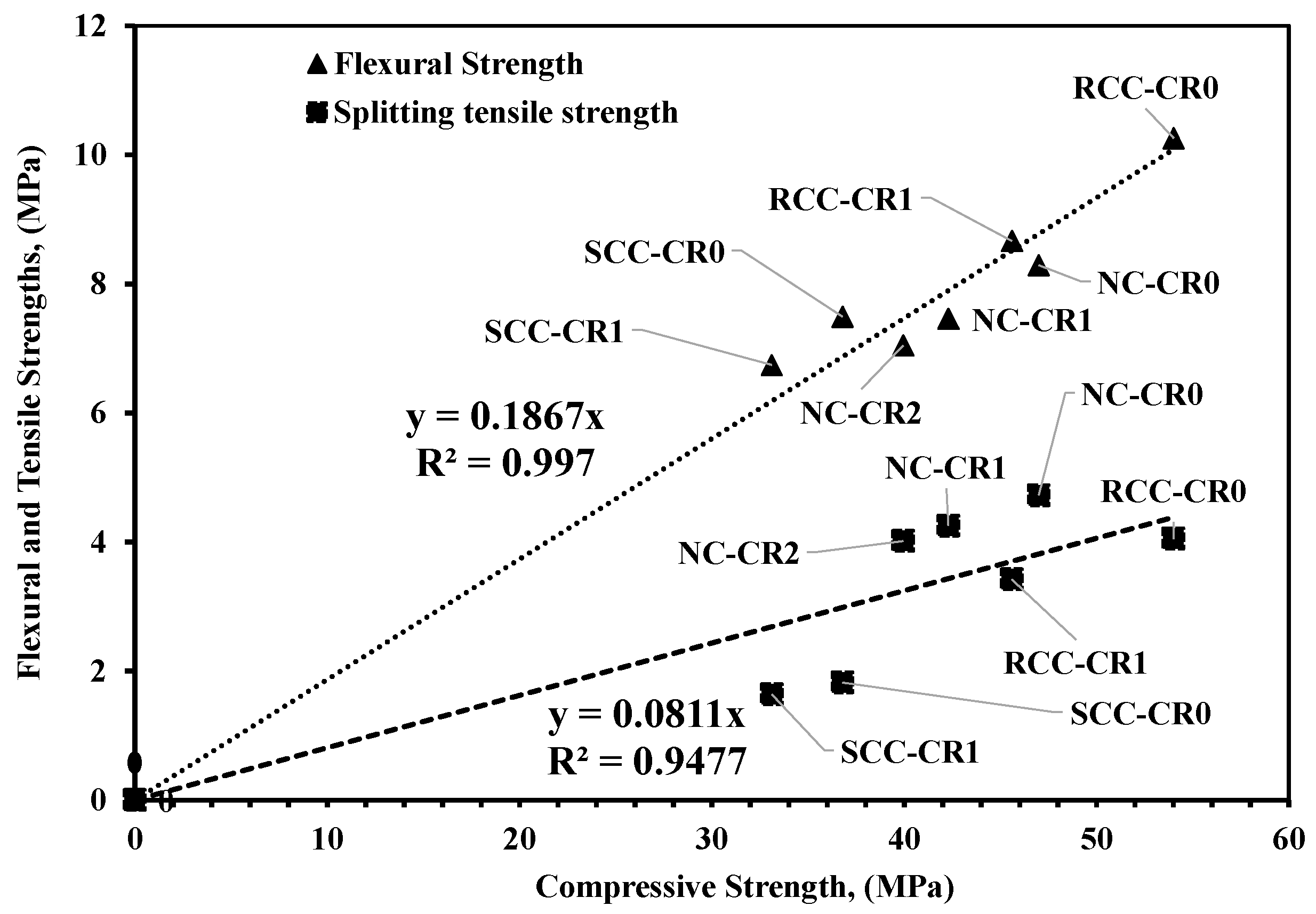


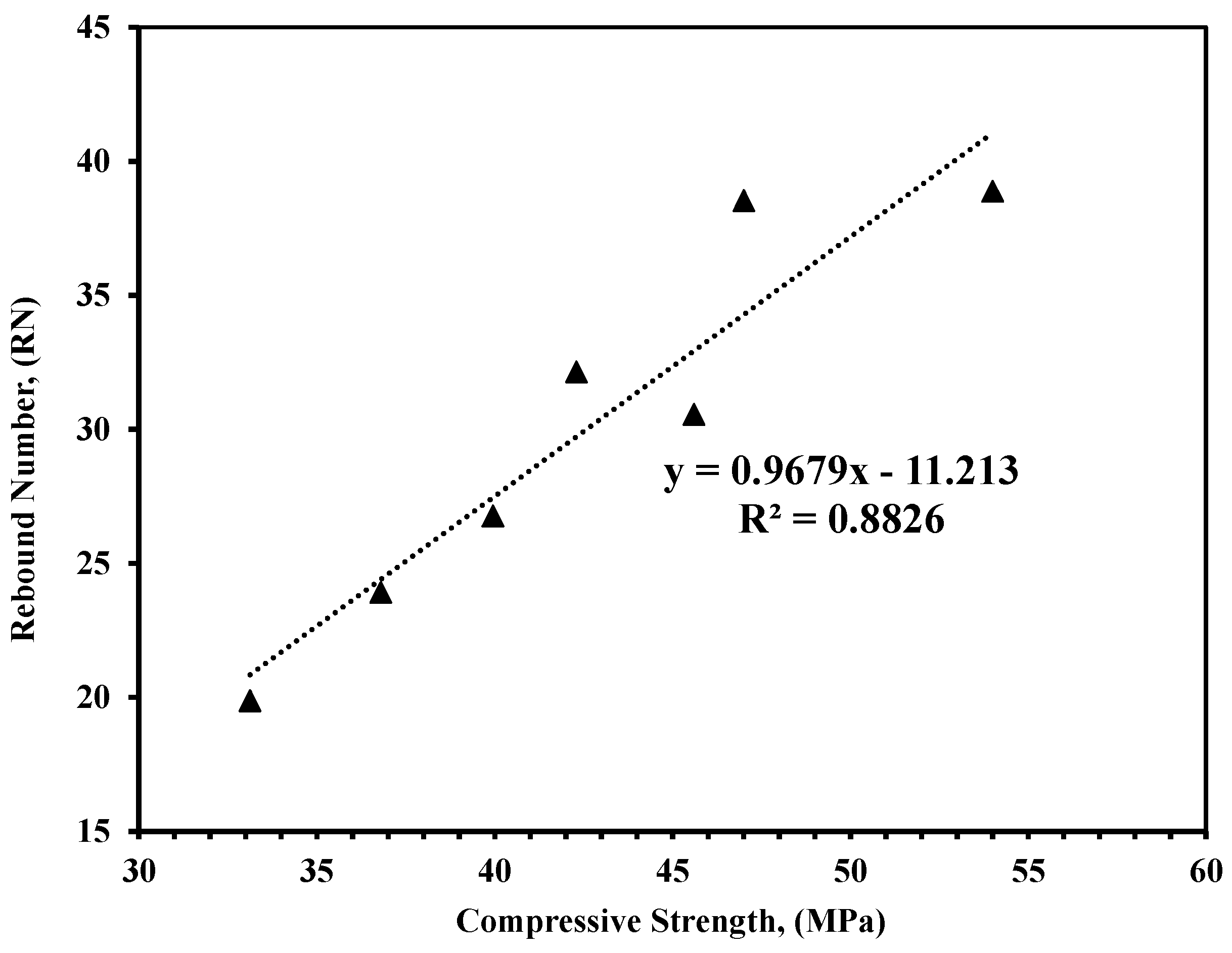
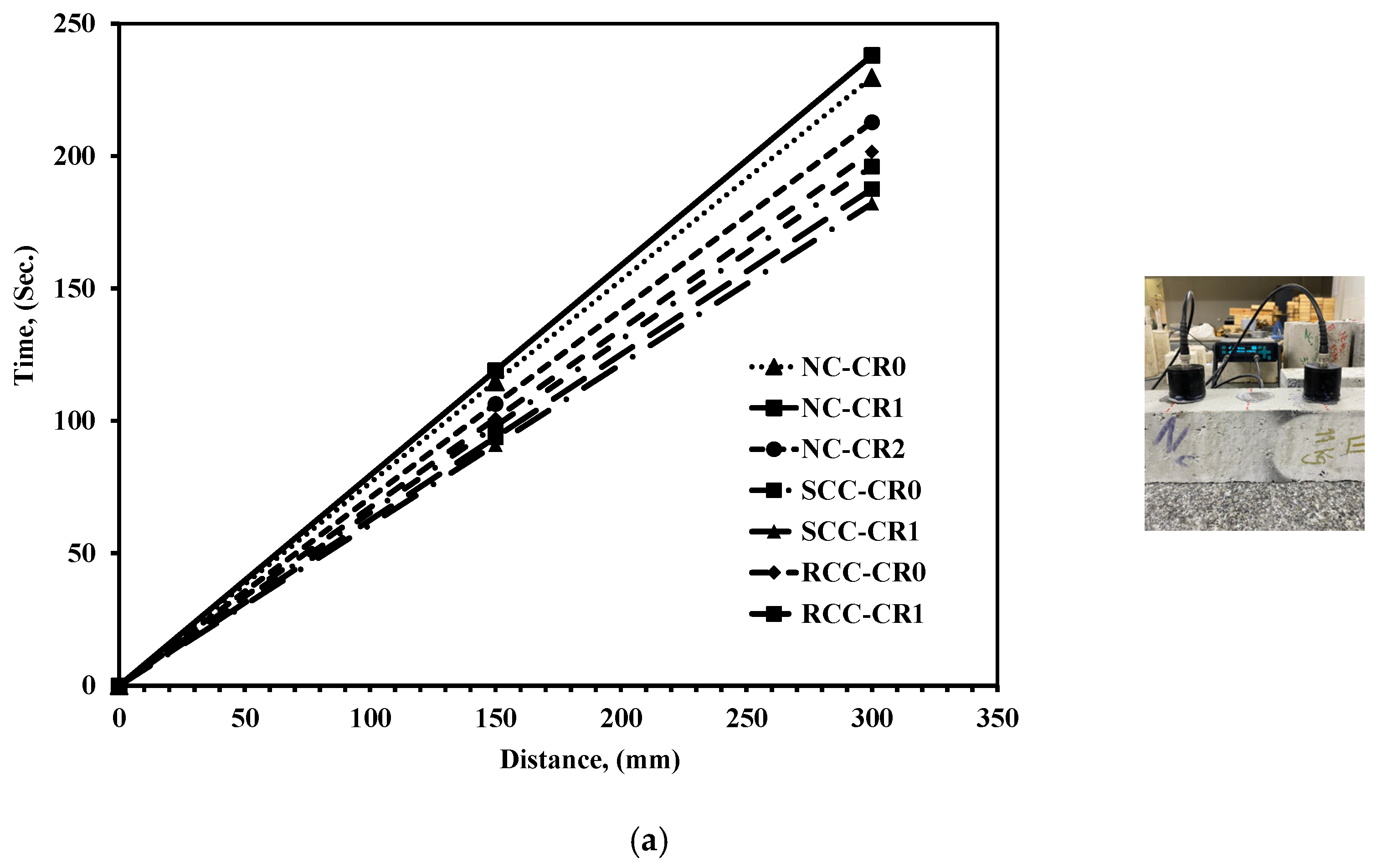
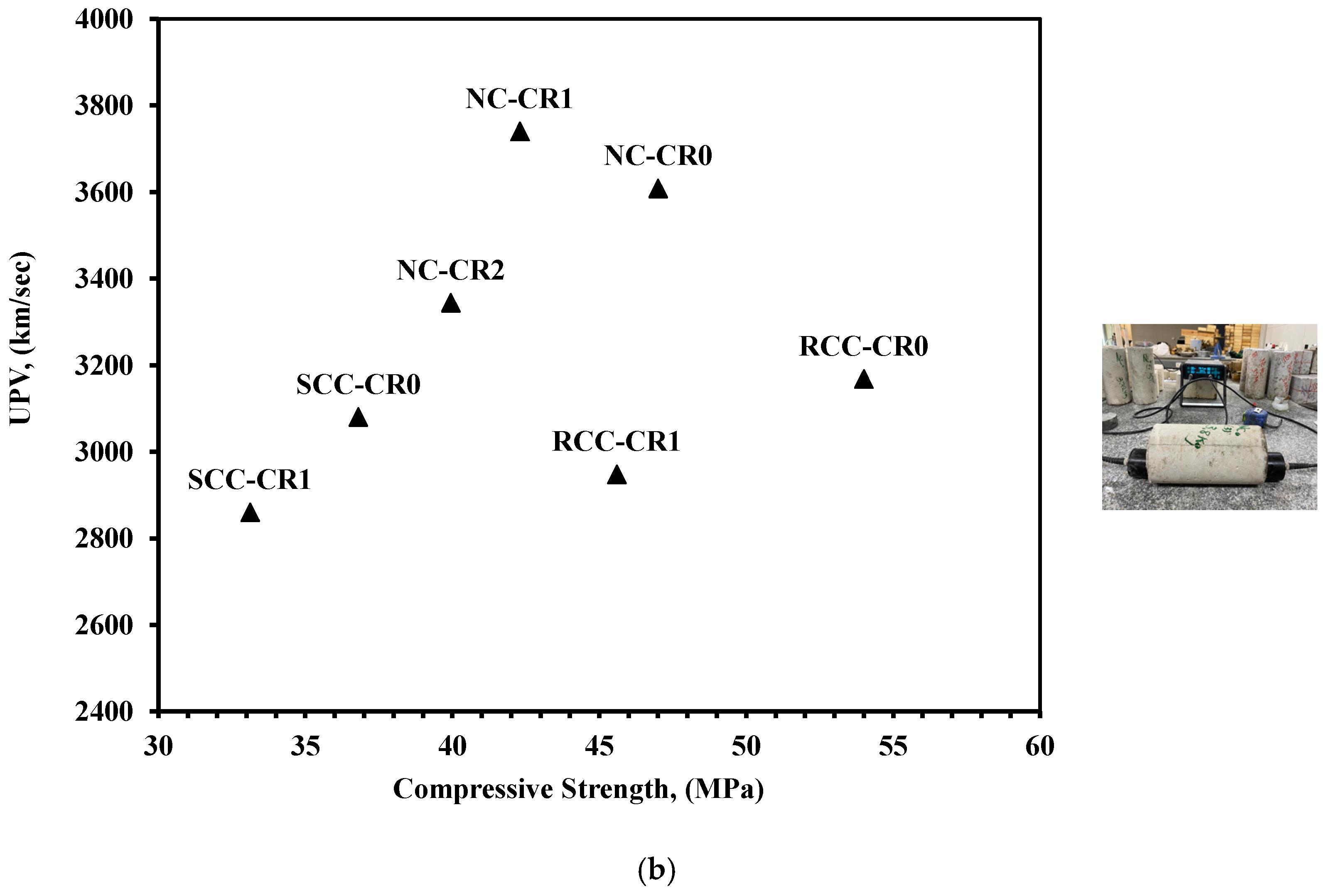
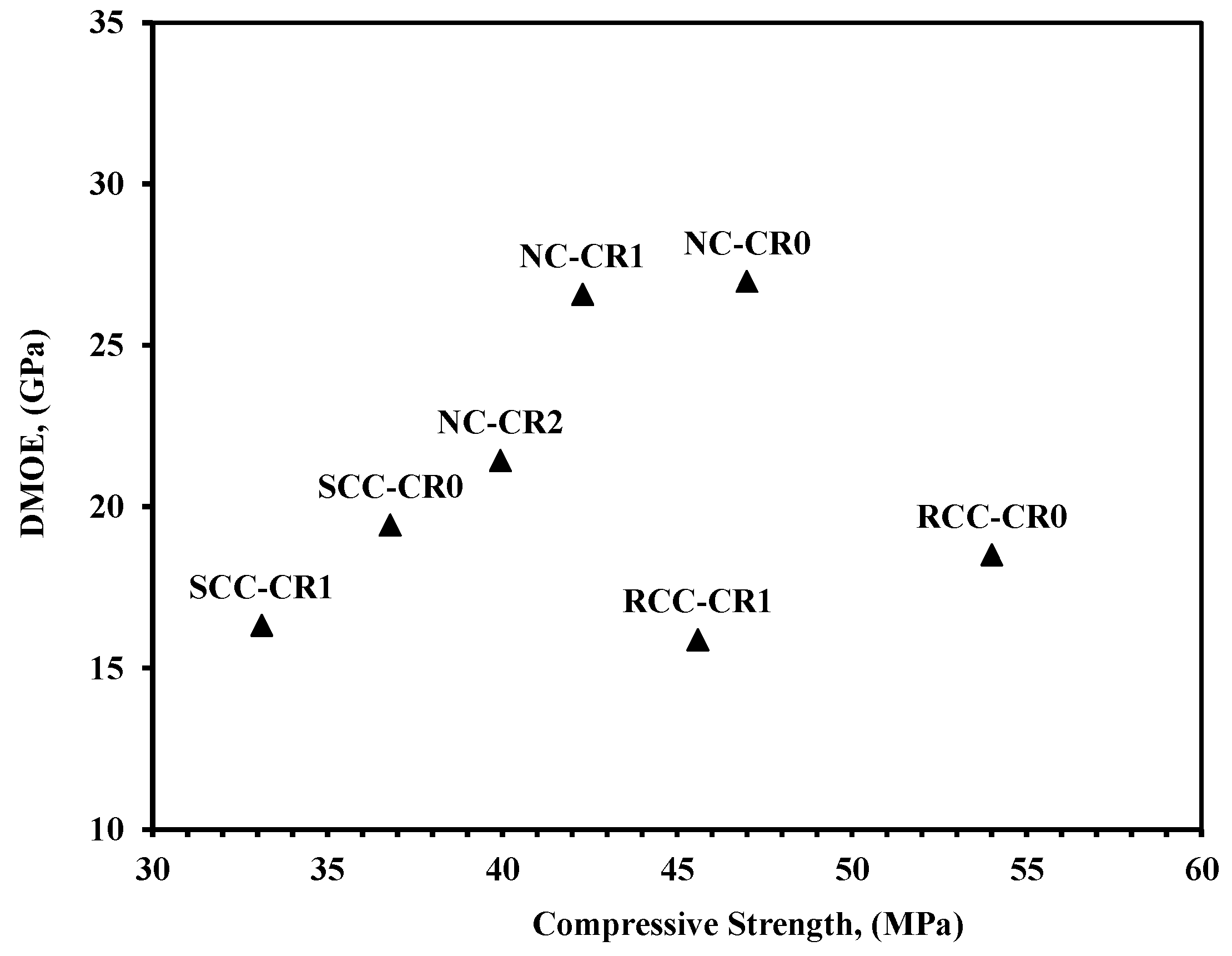
| Reference | Replacement (%) | Replaced Components | Quantity | Flow-Ability/Passing-Ability | Mechanical Properties @ 28 Days | NDT Handling | Treatment | Remarks | ||||
|---|---|---|---|---|---|---|---|---|---|---|---|---|
| By Volume | By Weight | Compressive Strength | Flexural Strength | Splitting Tensile Strength | Treated (T) or Untreated (U) | Treatment Type | ||||||
| Ismail and Hassan [40] | till 50% | FA | x | ↓ | 16–67% ↓ | 3–42% ↓ | 1–57% ↓ | NA | U | Elastic modulus testing | ||
| AbdelAleem and Hassan [41] | till 40% | FA | x | ↓ | till 68.3% ↓ | till 53.15% ↓ | till 52% ↓ | NA | U | |||
| Ganesan et al. [42] | 15, 20% | FA | x | ↓ | 1–13% ↓ | 9–15% ↑ | NA | NA | U | fatigue testing | ||
| Bideci et al. [43] | till 15% | CA | x | ↓ | 7–61% ↓ | NA | NA | Excellent to very good UPV | U | fracture energy | ||
| AbdelAleem et al. [44] | till 30% | FA | x | ↓ | 12–58% ↓ | till 31.57% ↓ | till 40% ↓ | NA | U | Adding fibers increases mechanical properties in general/impact resistance tests. | ||
| Ismail and Hassan [45] | till 30% | FA | x | ↓ | 57.9% ↓ | 31.7% ↓ | 40.3% ↓ | NA | U | impact resistance test | ||
| Mishra and Panda [46] | till 20% | CA | x | ↑ | 11–47% ↓ | 21.32% ↓ | 23.66% ↓ | NA | U | |||
| Aslani et al. [47] | 20% | CA | x | ↓ | 29–67% ↓ | NA | 50.27% ↓ | NA | T | water soaked in 24 h | ||
| Uygunoğlu and Topçu [48] | till 50% | FA | x | ↓ | 48–58% ↓ | 31–55% ↓ | NA | UPV 27–34% ↓ | U | water absorption/Dry shrinkage | ||
| Aslani et al. [49] | till 40% | FA | x | ↓ | 29–67% ↓ | NA | 13% ↑ | NA | U | |||
| Rahmani et al. [50] | till 15% | CA | x | ↑ | 15.5% ↓ | NA | NA | NA | U | increase of strength when adding SF up to 8.5% | ||
| Etli & Cemalgil [51] | till 20% | FA | x | ↓ | 16.58–29.87% ↓ | NA | 33.29% ↓ | NA | U | |||
| Chen et al. [52] | till 30% | FA | x | ↓ | ↓ | NA | NA | NA | U | Toughness resistance and elastic modulus | ||
| Raj et al. [53] | till 20% | FA | x | ↓ | 8–40% ↓ | 12–16% ↓ | 12–16% ↓ | NA | U | Modulus elasticity testing | ||
| Mallek et al. [54] | till 15% | FA and CA | x | ↓ | 38% ↓ | NA | NA | NA | U | Durability testing: carbonation depth, water absorption, chloride penetration, etc. | ||
| Anil et al. [55] | till 25% | FA | x | ↓ | NA | NA | NA | NA | U | Shear stresses | ||
| Bušić et al. [56] | till 30% | FA | x | ↓ | 35.5–70.9% ↓ | 15.1–70.7% ↓ | NA | NA | U | prediction Models | ||
| Yang et al. [57] | till 30% | FA | x | ↓ | 10–40% ↓ | NA | NA | NA | U | dynamic action compressive and bending strengths | ||
| Si et al. [58] | 15, 25% | FA | x | ↓ | 33–52% ↓ | NA | 19–33% ↓ | UPV ↓ | T | soaked in 1 N NaOH solution with stirring for about 20 min and washed then after | Durability testing | |
| Khalil et al. [59] | till 40% | FA | x | ↓ | 40% ↓ | 29% ↓ | 8.75% ↓ | NA | U | Impact resistance | ||
| Zaoiai et al. [60] | till 20% | FA and CA | x | ↓ | ≈37% ↓ | NA | 29–42% ↓ | NA | U | shrinkage testing | ||
| Güneyisi et al. [61] | till 25% | FA and CA | x | 7.0–50.6% ↓ | NA | NA | NA | U | ||||
| Miličević et al. [62] | 10% | FA | x | ↓ | 8% ↑ | NA | NA | NA | U | Microstructure analysis | ||
| Hesami et al. [63] | till 15% | FA | x | ↓ | 2–4.5% ↓ | 23.6–33% ↑ | 27% ↑ | UPV ↓ | U | |||
| Alaloul et al. [64] | 15, 30% | FA | x | ↓ | ≈92% ↓ | ≈78.9% ↓ | ≈84.6% ↓ | NA | U | |||
| Reference | Replacement (%) | Replaced Components | Quantity | Optimum Content | Mechanical Properties @ 28 Days | NDT Handling | Treatment | Remarks | ||||
|---|---|---|---|---|---|---|---|---|---|---|---|---|
| By Volume | By Weight | Compressive Strength | Flexural Strength | Splitting Tensile Strength | Treated (T) or Untreated (U) | Treatment Type | ||||||
| Keles et al. [65] | till 30% | FA + CA | x | 6.61–8.47% | 10–81% ↓ | 7–74% ↓ | 8–60% ↓ | 0.9–24.1% ↓ UPV | U | Elastic modulus testing/Microstructure | ||
| Mohammed et al. [66] | till 30% | FA | x | 5.46–6.09% | 9.7–36.26% ↓ | NA | NA | RN ↓/UPV 3.9–35.05% ↓ | U | |||
| Mohammed and Adamu [67] | till 30% | FA | x | 5.46–6.09% | 23.2% ↓ | 9.3–39.3%↑ | 18.7% ↑@ 10%/15–29.4% ↓ | NA | U | nano-silica addition increases the mechanical properties/elastic modulus testing/Abrasion testing | ||
| Adamu et al. [68] | till 15% | FA | x | 5.46–6.09% | rubber content ↑ mechanical properties ↓ nana-silica to 2% and fly addition to 50% mechanical properties ↑ | NA | U | impact resistance/elastic modulus/abrasion resistance testing/Microstructure | ||||
| Meddah et al. [69] | till 30% | FA | x | NA | Mechanical properties ↓ when Rubber content ↑ | NA | T | soaked in 1 N NaOH solution with stirring for about 24 h and dried at 60 °C in 24 h/adhesion of sand particles on rubber surfaces with resin | The pretreatment of rubber reduces the loss/elastic modulus testing | |||
| Fakhri and Saberi [70] | till 35% | FA | x | 5.50% | Compressive strength ↑ till 10% rubber and then ↓ | Flexural strength ↑ till 5% rubber and then ↓ | NA | NA | U | Absorption testing was handled. | ||
| Corinaldesi et al. [71] | 10, 30% | FA | x | NA | ↓ | ↓ | NA | NA | U | Thermal conductivity and microstructure testing/SP affect flexural strength adversely. | ||
| Adamu et al. [72] | till 30% | FA | x | 5.48–5.95% | 8.8–37% ↓ | 4.94–22.7% ↓/@10% 6.64–11.91% ↑ | 8.7–27.6% ↓ | NA | U | Suggested that the mineral admixture such as fly ash and silica fume added as filler instead of cement to higher strengths except for flexural the strength improvement would be reached at 10% only in all cases/ductility, toughness, and water absorption were measured | ||
| Jingfu et al. [73] | 5, 100, 120 kg/m3 | FA | x | NA | 4.37–14.56% ↓ | 11.3–22.4% ↑ | 5–19% ↑ | NA | U | Elastic modulus and drying shrinkage are tested. | ||
| Adamu et al. [74] | till 30% | FA | x | NA | Compressive strength ↑ till 10% rubber and then ↓ | NA | NA | NA | U | Compressive strength improved when nano silica of 2% was added; above 2%, the strength was reduced. | ||
| Components | Cement, (%) |
|---|---|
| SiO2 | 25.3 |
| Al2O3 | 6.64 |
| Fe2O3 | 6.68 |
| CaO | 58.44 |
| MgO | 2.29 |
| P2O5 | 0 |
| K2O | 0.25 |
| Na2O | 0.66 |
| SO3 | 2.04 |
| Cl | 0.06 |
| TiO2 | - |
| SrO2 | - |
| Mn2O3 | - |
| LOI | 4 |
| Mix ID | w/c | Water (kg/m3) | Cement (kg/m3) | Nano Silica Fume (kg/m3) | Sand (kg/m3) | Coarse Aggregate (kg/m3) | Rubber (kg/m3) | Treatment | Fly ash (kg/m3) | Superplasticizer (Kg/M3) | Viscosity (kg/m3) | Remarks |
|---|---|---|---|---|---|---|---|---|---|---|---|---|
| NC-CR0 | 0.5 | 182.5 | 365 | 0 | 730 | 1096 | 0 | 0 | 0 | 0 | ||
| NC-CR1 | 0.5 | 182.5 | 365 | 0 | 730 | 830 | 122.61 | NaOH treatment 24 h (1 N) | 0 | 0 | 0 | 25% CA by volume |
| NC-CR2 | 0.5 | 182.5 | 365 | 0 | 730 | 830 | 122.61 | Cement paste | 0 | 0 | 0 | |
| SCC-CR0 | 0.4 | 180 | 450 | 0 | 800 | 950 | 0 | 0 | 5.85 | 0.9 | ||
| SCC-CR1 | 0.4 | 180 | 450 | 0 | 729 | 860 | 77.23 | NaOH treatment 24 h (1 N) | 0 | 5.85 | 0.9 | 10% of the total aggregate volume |
| RCC-CR0 | 0.7199 | 96.90 | 134.6 | 2.4 | 1300 | 833 | 0 | 102.5 | 0 | 0 | ||
| RCC-CR1 | 0.7199 | 96.90 | 134.6 | 2.4 | 1170 | 833 | 56.42 | NaOH treatment 24 h (1 N) | 102.5 | 0 | 0 | 10% FA by volume |
| The Rheological Test | Units | Limits | |
|---|---|---|---|
| Min. | Max. | ||
| Slump Flow (diameter) | mm | 600 | 800 |
| Time for reaching slump flow with a diameter of 500 mm (T50 cm) | s | 2 | 5 |
| J-ring slump flow (diameter) | mm | 0 | 20 |
| V-funnel after immediate mixing (to) | s | 6 | 12 |
| V-funnel after 5 min from mixing (t5min.) | s | to | to + 3 |
| L-box (H2/H1) | ratio | 0.80 | 1.0 |
| Concrete Type | Testing | The Codes Guidelines and Standards | Equations | Description |
|---|---|---|---|---|
| NC | slump | ASTM C143 [83] | NA | Normal slump test |
| RCC | slump | NA | Normal slump test to ensure zero or stiff slump | |
| Rheological SCC | Slump flow test | ECP 203 [76] ASTM C1611 [84] | where D1 and D2 are the slump diameters perpendicularly to each other. | Fresh concrete is placed into the frustum on the rigid plate. The frustum is then removed so that the freshly mixed concrete would flow into a diameter range between 600 and 800 mm. |
| Slump flow time at T50 cm | Fresh concrete is poured inside the frustum. The time elapsed for the slump flow to reach a diameter of 500 mm engraved on the rigid plate is measured in seconds. | |||
| J-ring flow | ASTM C1621 [85] | The test examines the ability of concrete to pass (pass ability) through a reinforcement diameter of 16 mm and spacing of 59 mm. | ||
| V-funnel | EN 12350-9 [86] | The V-funnel measures the time elapsed for falling the concrete into the cylinder, which is denoted by (to). | ||
| V-funnel after 5 min | The freshly mixed concrete was left for 5 min. The time elapsed is measured for falling the concrete into the cylinder is calculated from (to) till (to + 3) | |||
| L-Box test | EN 12350-10 [87] | where H1 is the concrete height in the vertical section, while H2 is the horizontal end of the section | The passing ability of SCC is measured passing by the concrete’s weight through tight openings including congested reinforcement at certain spacing. |
| Concrete Type | Testing | The Codes Guidelines and Standards | Description |
|---|---|---|---|
| Mechanical properties | Compressive strength | EGP 203 [76] | Cubes were loaded in compression at 240 kg/cm2 per minute pacing rate until the specimens failed. |
| Flexural Strength | Prisms were loaded in compression onto the longitudinal direction at a 24 kg/cm2 per minute pacing rate. | ||
| Splitting Tensile Strength | Cylinders were loaded in compression longitudinally at a 12 to 24 kg/cm2 per minute pacing rate. | ||
| Impact resistance | BS 812: Part 112 [88], ACI 544.2R [89], Eren et al. [90] | A specimen of 150-mm-diameter and 60-mm-thick cylinders was tested by a drop-weight modified [88,89,90] to obtain the number of the average blows causing the first crack and final fracture at 28 days of age. |
| S/N | UPV Range of Values (m/s) | Concrete Classification/Quality Rating |
|---|---|---|
| 1 | UPV > 4500 | Excellent |
| 2 | 4500 > UPV > 3500 | Good |
| 3 | 3500 > UPV > 3000 | Medium |
| 4 | 3000 > UPV > 2000 | Doubtful |
| 5 | UPV < 2000 | Very weak |
| The Rheological Test | Units | Test Values | |
|---|---|---|---|
| SCC-CR0 | SCC-CR1 | ||
| Slump Flow (diameter) | mm | 700 | 650 |
| Time for reaching slump flow with a diameter of 500 mm (T50 cm) | s | 2.5 | 3 |
| J-ring slump flow (diameter) | mm | 12 | 10 |
| V-funnel after immediate mixing (to) | s | 8 | 9 |
| V-funnel after 5 min from mixing (t5min.) | s | 10 | 11 |
| L-box (H2/H1) | ratio | 0.9 | 0.87 |
| Mix ID | No of Blows Corresponding to the First Crack (N1) | No of Blows Corresponding to the Fracture (N2) | N2 − N1 |
|---|---|---|---|
| NC-CR0 | 150 | 152 | 2 |
| NC-CR1 | 169 | 173 | 4 |
| NC-CR2 | 165 | 168 | 3 |
| SCC-CR0 | 143 | 145 | 2 |
| SCC-CR1 | 165 | 168 | 3 |
| RCC-CR0 | 148 | 151 | 3 |
| RCC-CR1 | 157 | 161 | 4 |
| Mix ID | DMOE |
|---|---|
| NC-CR0 | 26.97 |
| NC-CR1 | 26.57 |
| NC-CR2 | 21.43 |
| SCC-CR0 | 19.43 |
| SCC-CR1 | 16.32 |
| RCC-CR0 | 18.51 |
| RCC-CR1 | 15.88 |
Disclaimer/Publisher’s Note: The statements, opinions and data contained in all publications are solely those of the individual author(s) and contributor(s) and not of MDPI and/or the editor(s). MDPI and/or the editor(s) disclaim responsibility for any injury to people or property resulting from any ideas, methods, instructions or products referred to in the content. |
© 2024 by the authors. Licensee MDPI, Basel, Switzerland. This article is an open access article distributed under the terms and conditions of the Creative Commons Attribution (CC BY) license (https://creativecommons.org/licenses/by/4.0/).
Share and Cite
El-Nemr, A.; Shaaban, I.G. Assessment of Special Rubberized Concrete Types Utilizing Portable Non-Destructive Tests. NDT 2024, 2, 160-189. https://doi.org/10.3390/ndt2030010
El-Nemr A, Shaaban IG. Assessment of Special Rubberized Concrete Types Utilizing Portable Non-Destructive Tests. NDT. 2024; 2(3):160-189. https://doi.org/10.3390/ndt2030010
Chicago/Turabian StyleEl-Nemr, Amr, and Ibrahim G. Shaaban. 2024. "Assessment of Special Rubberized Concrete Types Utilizing Portable Non-Destructive Tests" NDT 2, no. 3: 160-189. https://doi.org/10.3390/ndt2030010





